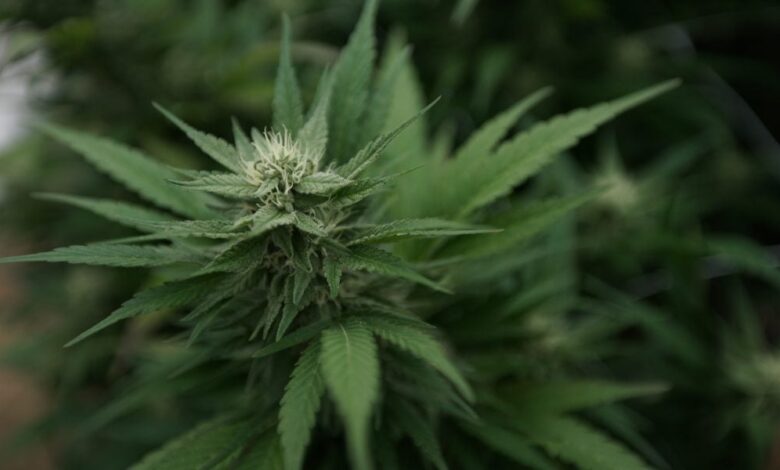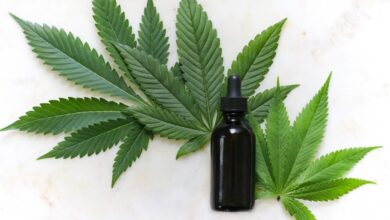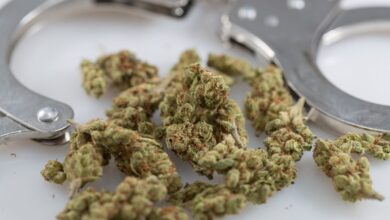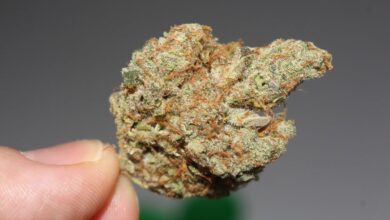Traffic Safety Official Emphasizes Need For Roadside Marijuana Testing At Congressional Transportation Hearing

The problem of marijuana-impaired driving arose once more at congressional listening to final week, with a consultant of the Governors Freeway Security Affiliation emphasizing the significance of roadside drug testing as a instrument to assist fight lethal automobile crashes.
“I feel the at the beginning factor that’s going to help us in stopping these tragedies from happening is oral fluid roadside testing,” mentioned Michael Hanson, who’s additionally director of site visitors security on the Minnesota Division of Public Security.
Hanson was responding to a query from Home Transportation & Infrastructure Subcommittee on Highways and Transit member Rep. Rob Bresnahan (R-PA), who had requested how one can handle considerations round impaired driving.
“With states getting out in entrance of federal laws regarding marijuana particularly,” he mentioned, “do you’ve got any suggestions or concepts or applied sciences that we are able to begin to implement that will detect a extra instantaneous stage of impairment?”
In response, Hanson pointed to saliva testing for instance of “devices and expertise” that regulation enforcement officers might deploy within the area “to detect current use of a hashish product that could be a sturdy indicator that that particular person could also be impaired.”
“Placing these instruments within the arms of regulation enforcement to stop that from occurring—or permit them to course of anyone who could also be impaired—goes to be necessary,” he instructed lawmakers on the February 12 hearing.
Written testimony from Catherine Chase, president of Advocates for Freeway and Auto Security, additionally pointed to measures akin to “extending zero tolerance for below age 21 and open container legal guidelines to incorporate marijuana use and its merchandise”—legal guidelines already on the books in most states with authorized hashish.
With greater than three quarters of all U.S. states having legalized marijuana for both medical or grownup use, and in gentle of the potential of federal rescheduling of the drug, considerations about freeway security loom giant earlier than policymakers. Although there’s no broadly agreed-upon option to take a look at impairment by drivers at a roadside cease, efforts to develop and deploy area assessments that display for current use have turn out to be extra pressing lately.
The Nationwide Institute of Requirements and Know-how (NIST), for example, is planning to convene authorities officers, forensics specialists, teachers, business representatives, regulation enforcement and requirements organizations in April for what it describes as “an open and candid dialogue” about “the trail ahead to comprehend significant hashish breathalyzer expertise and implementation.”
Matters to be mentioned will embody challenges going through marijuana breathalyzer design and improvement, obstacles to prosecutors dealing with drugged-driving circumstances and the way NIST and others may accomplice to advance the expertise.
Impaired driving is of explicit concern to the trucking business, which has raised worries that rescheduling marijuana might complicate zero-tolerance drug insurance policies.
Bresnahan at a separate congressional listening to final month requested Cargo Transporters Inc. CEO Dennis Dellinger, who was testifying on behalf of the American Trucking Associations (ATA), whether or not there was “something particularly that Congress can do, or advocate for, to detect that speedy stage of impairment with the half-lives of marijuana remaining inside techniques.”
Dellinger replied that he thinks “there’s a false impression on the market, [with] marijuana or hashish being authorized, that folks can function automobiles below the affect, and that could be a drawback.”
“We do not need a take a look at that tells us if you’re below the affect or not, so we have now to depend on the present urine take a look at or the hair take a look at, which assessments again [beyond active impairment],” he mentioned. “And I suppose the battle we have now in our business is we are able to’t compromise the system we have now till there’s a workable answer for a take a look at to know whether or not you might be really below the affect on the time.”
“I feel, in our firm, if we had an accident at any diploma, and we had post-accident assessments and we examined optimistic, we’d battle defending something in that accident,” Dellinger continued. “And the retribution we’d get for that from the general public, from the media, can be astonishing. So our place is that, proper now, we have now to just accept the testing that we have now.”
In 2023, the U.S. Division of Transportation (DOT) finalized a rule allowing one other various choice to screening urine samples: saliva-based testing. Relying on frequency of use, THC is mostly detectable in saliva anyplace from one to 24 hours after use, in line with the company.
Whereas saliva or blood assessments can detect current marijuana use higher than urine or hair samples, nonetheless, there’s one other wrinkle: In keeping with current feedback by a U.S. Division of Justice (DOJ) researcher, it’s unclear whether or not an individual’s THC ranges are even a dependable indicator of impairment.
On a podcast final yr, Frances Scott, a bodily scientist on the Nationwide Institute of Justice (NIJ) Workplace of Investigative and Forensic Sciences below DOJ, questioned the efficacy of setting “per se” THC limits for driving. Finally, she mentioned, there will not be a option to assess impairment from THC ranges, as regulation enforcement does for alcohol.
One complication is that “in case you have persistent customers versus rare customers, they’ve very totally different concentrations correlated to totally different results,” Scott mentioned. “So the identical impact stage, if you’ll, can be correlated with a really totally different focus of THC within the blood of a persistent person versus an rare person.”
Final October, a research preprint posted on The Lancet by an eight-author group representing Canada’s Centre for Dependancy and Psychological Well being, Well being Canada and Thomas Jefferson College in Philadelphia recognized and assessed a dozen peer-reviewed research measuring “the energy of the linear relationship between driving outcomes and blood THC” printed by means of September 2023.
“The consensus is that there isn’t any linear relationship of blood THC to driving,” the paper concluded. “That is shocking provided that blood THC is used to detect cannabis-impaired driving.”
Most states the place hashish is authorized measure THC intoxication by whether or not or not somebody’s blood THC ranges are under a sure cutoff. The research’s findings recommend that counting on blood ranges alone could not precisely mirror whether or not somebody’s driving is impaired.
“Of the 12 papers included within the current assessment,” authors wrote, “ten discovered no correlation between blood THC and any measure of driving, together with [standard deviation of lateral position (SDLP)], velocity, automobile following, response time, or total driving efficiency. The 2 papers that did discover a important affiliation have been from the identical research and located important relationship with blood THC and SDLP, velocity and following distance.”
The problem was additionally examined in a federally funded research final yr that recognized two totally different strategies of extra precisely testing for current THC use that accounts for the truth that metabolites of the cannabinoid can keep current in an individual’s system for weeks or months after consumption.
A 2023 congressional report for a Transportation, Housing and City Improvement, and Associated Companies (THUD) invoice mentioned that the Home Appropriations Committee “continues to help the event of an goal normal to measure marijuana impairment and a associated area sobriety take a look at to make sure freeway security.”
A yr earlier Sen. John Hickenlooper (D) of Colorado despatched a letter to the Division of Transportation (DOT) in search of an replace on that standing of a federal report into analysis boundaries which are inhibiting the event of a standardized take a look at for marijuana impairment on the roads. The division was required to finish the report below a large-scale infrastructure invoice that President Joe Biden signed, however it missed its reporting deadline.
In the meantime, Nationwide Transportation Security Board (NTSB) final yr warned that marijuana rescheduling might create a “blind spot” with respect to drug testing of federally regulated staff in safety-sensitive positions—regardless of assurances from then-U.S. Transportation Secretary Pete Buttigieg that the hashish rescheduling proposal “wouldn’t alter” the federal drug testing necessities.
At a Home committee listening to, Buttigieg had referenced considerations from ATA “in regards to the broad public well being and security penalties of reclassification on the nationwide freeway system and its customers,” which the trucking affiliation voiced in a letter to the secretary.
As extra states legalize marijuana, a federal report printed final yr confirmed that the variety of optimistic drug assessments amongst industrial drivers fell in 2023 in comparison with the yr earlier than, dropping from 57,597 in 2022 to 54,464 within the prior yr. On the identical time, nonetheless, the variety of drivers who refused to be screened in any respect additionally elevated by 39 %.
One other query discovered that 65.4 % of motor carriers believed present marijuana testing procedures ought to be changed with strategies that measure lively impairment.
On the time, the report from the American Transportation Analysis Institute (ATRI) famous a 65,000-driver deficit within the nation and mentioned the concern of positives over marijuana metabolites—which may stay in an individual’s blood far lengthy after lively impairment—could also be holding would-be drivers out of the business.
The record-high variety of refusals got here because the transportation business faces a nationwide scarcity of drivers, which some commerce teams have mentioned has solely been made worse by drug testing insurance policies that threat flagging drivers even after they’re not impaired on the job.
Present federal regulation mandates that industrial drivers abstain from hashish, subjecting them to numerous types of drug screening, from pre-employment to randomized testing.
In June 2022, in the meantime, an ATRI survey of licensed U.S. truck drivers discovered that 72.4 % supported “loosening” hashish legal guidelines and testing insurance policies. One other 66.5 % mentioned that marijuana ought to be federally legalized.
Hashish reform advocates, in the meantime, have additionally referred to as on federal officers to vary what they name “discriminatory” drug testing practices across the trucking business.
A high Wells Fargo analyst mentioned in 2022 that there’s one foremost motive for rising prices and employee shortages within the transportation sector: federal marijuana criminalization and ensuing drug testing mandates that persist at the same time as extra states enact legalization.
Then-Rep. Earl Blumenauer (D-OR) despatched a letter to the pinnacle of DOT in 2022, emphasizing that the company’s insurance policies on drug testing truckers and different industrial drivers for marijuana are unnecessarily costing individuals their jobs and contributing to provide chain points.
The 2022 ATRI report famous that analysis into the influence of hashish use on driving and freeway security is at the moment blended, complicating rulemaking to deal with the difficulty. A separate 2019 report from the Congressional Analysis Service (CRS) equally discovered that proof about hashish’s capability to impair driving is inconclusive.
A research printed in 2019 concluded that those that drive on the authorized THC restrict—which is usually between two to 5 nanograms of THC per milliliter of blood—weren’t statistically extra prone to be concerned in an accident in comparison with individuals who haven’t used marijuana.
Individually, the Congressional Analysis Service in 2019 decided that whereas “marijuana consumption can have an effect on an individual’s response occasions and motor efficiency … research of the influence of marijuana consumption on a driver’s threat of being concerned in a crash have produced conflicting outcomes, with some research discovering little or no elevated threat of a crash from marijuana utilization.”
One other research from 2022 discovered that smoking CBD-rich marijuana had “no important influence” on driving capability, even though all research individuals exceeded the per se restrict for THC of their blood.
Evan way back to 2015, a U.S. Nationwide Freeway Site visitors Security Administration (NHTSA) concluded that it’s “tough to determine a relationship between an individual’s THC blood or plasma focus and efficiency impairing results,” adding that “it’s inadvisable to try to predict results based mostly on blood THC concentrations alone.”
In a separate report final yr, NHTSA mentioned there’s “comparatively little analysis” backing the concept THC focus within the blood can be utilized to find out impairment, once more calling into query legal guidelines in a number of states that set “per se” limits for cannabinoid metabolites.
“A number of states have decided authorized per se definitions of hashish impairment, however comparatively little analysis helps their relationship to crash threat,” that report mentioned. “Not like the analysis consensus that establishes a transparent correlation between [blood alcohol content] and crash threat, drug focus in blood doesn’t correlate to driving impairment.”
Picture courtesy of Chris Wallis // Aspect Pocket Photographs.




